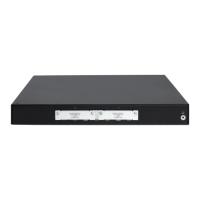101
Step Command Remarks
1. Enter system view.
system-view
N/A
2. Enter Layer 2
Ethernet interface
view.
interface
interface-type interface-number
N/A
3. Enable the 802.1X
MAC address
binding feature.
dot1x binding-mac enable
By default, the 802.1X
MAC address binding
feature is disabled.
4. Manually configure
802.1X MAC
address binding
entries.
dot1x binding-mac
mac-address
Optional.
By default, no 802.1X
MAC address binding
entries are configured on
the port.
Displaying and maintaining 802.1X
Task Command Remarks
Display 802.1X session
information, statistics, or
configuration information of
specified or all ports.
display dot1x
[
sessions
|
statistics
]
[
interface
interface-list ] [
|
{
begin
|
exclude
|
include
} regular-expression ]
Available in any view.
Clear 802.1X statistics.
reset dot1x statistics
[
interface
interface-list ]
Available in user view.
802.1X authentication configuration example
Network requirements
As shown in Figure 43, the access device performs 802.1X authentication for users that connect to
port Ethernet 1/1. Implement MAC-based access control on the port, so the logoff of one user does
not affect other online 802.1X users.
Use RADIUS servers to perform authentication, authorization, and accounting for the 802.1X users.
If RADIUS authentication fails, perform local authentication on the access device. If RADIUS
accounting fails, the access device logs the user off.
Configure the host at 10.1.1.1/24 as the primary authentication and accounting servers, and the host
at 10.1.1.2/24 as the secondary authentication and accounting servers. Assign all users to the ISP
domain aabbcc.net, which accommodates up to 30 users.
Configure the shared key as name for packets between the access device and the authentication
server, and the shared key as money for packets between the access device and the accounting
server.

